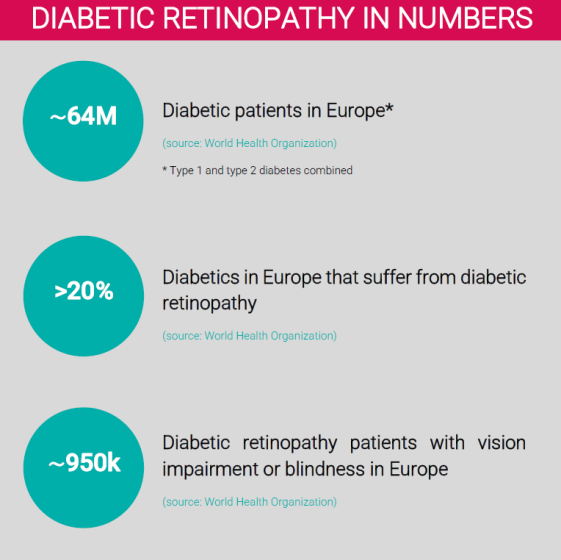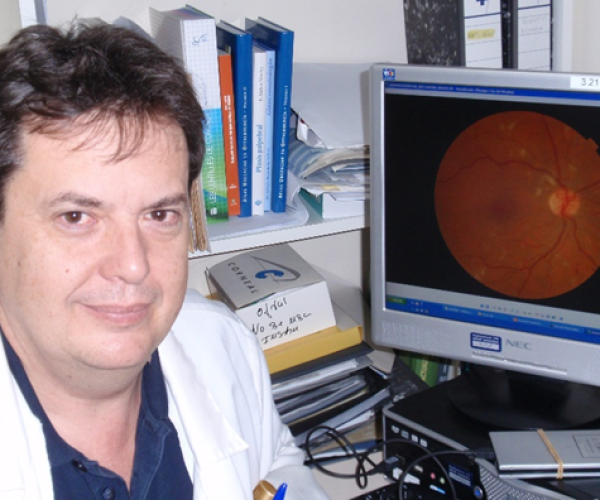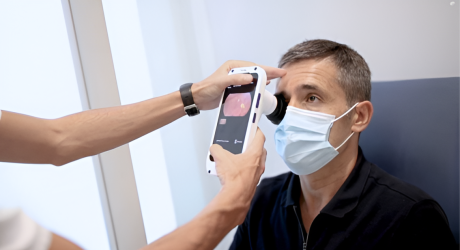RETINA READ RISK – Retrospective of the Retina Read Risk Project
Prof. Pere Romero-Aroca, Principal Investigator, Retina Read Risk (photo: PRA).
About Retina Read Risk
Retina Read Risk was officially launched in 2022. The goal of this 3-year project is to develop hardware and software for a new vision-screening process for diabetic retinopathy (DR) that, compared to previously developed methods, is both safer for patients and less time-consuming for medical staff. Retina Read Risk is a multidisciplinary endeavor centered on patient and caregiver perspectives. The project consortium includes various innovation partners: research laboratories, hospitals, a patient association, one of the world’s largest telecom groups, a hospital telecom service-provider, a consulting firm specialized in launching health start-ups, and a non-profit foundation that funds applied medical research. They share a common objective: to improve and personalize vision-screening of diabetic patients through E-health systems.
Featured interview: Professor Pere Romeo-Aroca
This issue features an interview with the project’s Principal Investigator, Prof. Pere Romeo-Aroca. He provides important background information on diabetic retinopathy, explains the approach used by Retina Read Risk to address current needs in vision-screening among diabetic patients, and outlines the advantages of Retina Read Risk compared to other approaches.
Update on the clinical trial
The first clinical trial on Retina Read Risk, launched in Spain in October 2022, has involved nearly 4,200 screenings to date. It is providing data for, and will ultimately demonstrate the efficacy and reliability of, the Artificial Intelligence (AI) component of Retina Read Risk, which has already detected diabetic retinopathy at different stages (mild, moderate or severe-proliferative) in 388 patients. Thanks to the patients and clinicians who participated in the trial, the consortium will continue to advance Retina Read Risk towards routine clinical use.

RRR: Please tell us a bit about yourself, your lab and your research.
PRA: As a Professor of Ophthalmology at the University Rovira i Virgili, Head of Ophthalmology at the Hospital Universitari Sant Joan de Reus, and researcher at the Pere Virgili Health Research Institute (IISPV), I have been dedicated to the diagnosis and treatment of diabetic retinopathy (see below) for more than 25 years. In the past 10 years, my research group has been focused on developing two algorithms: MIRA, for the detection of DR through automatic image-reading; and RETIPROGRAM, which predicts the risk of developing DR and stratifies DR screening between 12 and 36 months.
RRR: How does diabetes cause eye damage?
PRA: Diabetes affects vision in the form of retinal damage called diabetic retinopathy (DR), which leads to low vision or even blindness in patients if it is not detected early.
RRR: How common is diabetic retinopathy in the world population?
PRA: The epidemiology of DR varies by country. In developed countries, around 20% of diabetics have DR, with new cases arising in 4-7% of the diabetic population annually, whereas in undeveloped countries, epidemiology data vary due to the difficulty in obtaining reliable data. It is estimated that in Africa, between 30% and 40% of patients with diabetes mellitus have DR, with the severe forms being the most frequent.
RRR: Is that eye damage treatable or preventable?
PRA: The prevention of DR involves screening the retina, through annual retinographies in diabetic patients. If DR is detected, or there are important risk factors without DR, strict control of glycemia and blood pressure can slow down both its onset and its evolution.
RRR: Can you explain the problem that you are trying to solve with the project Retina Read Risk, your proposed solution and how it addresses the needs of diabetic patients?
PRA: The prevalence of DM in the population is 15%, which makes screening all diabetic patients annually by traditional methods unfeasible. Therefore, to access the greatest possible number of patients, the screening must draw on different experts and artificial intelligence techniques. To this end, we have developed the two algorithms that I mentioned before: MIRA, which automatically reads images, thereby speeding up patient screening; and RETIPROGRAM, which predicts DR and allows screening to be stratified over time, between 12 and 36 months, according to nine risk factors.
RRR: Previous work in this area done by other groups yielded mixed results on the quality of smartphone photography for diagnosing DR. How does your team aim to improve on that earlier work?
PRA: The current generation of detection equipment uses systems that include mobile phones incorporated into the imaging equipment. However, in all cases, they require the patients’ pupils to be dilated, making them unfeasible. For this reason, we have opted for portable retinographs, which, being almost identical in terms of equipment, enable us to obtain even better images, without the need for pupillary dilation.
RRR: Will you establish standardized parameters that could be used by patients and healthcare professionals all around the world?
PRA: Automatic reading algorithms can be directly associated either with the portable retinograph or with the patients’ clinical history. Moreover, the risk of DR development establishes the stratification of patients with a screening window longer than the 12 months currently required. We believe that to facilitate screening for DR, the image-acquisition equipment must avoid the need for pupillary dilation and, whenever possible, be portable.

For more information visit: www.eithealth.eu. You can contact us by email: contact@retinareadrisk.eu
The Retina Read Risk project is funded by the European Union. Views and opinions expressed are however those of the author(s) only and do not necessarily reflect those of the European Union or the EIT. Neither the European Union nor the granting authority can be held responsible for them. This project (reference 230123) is supported by EIT Health, a knowledge and innovation community of the European Institute of Innovation and Technology (EIT).



